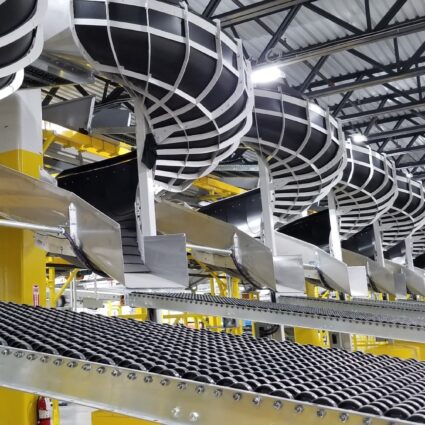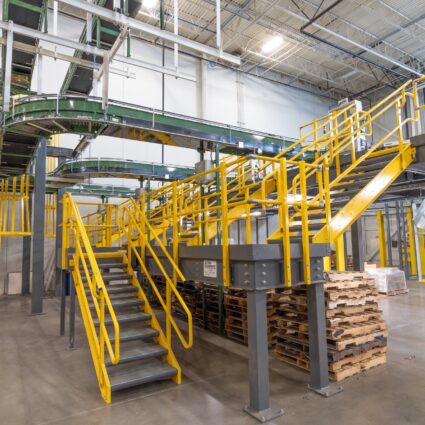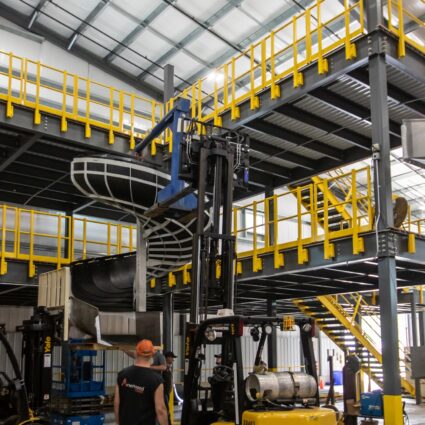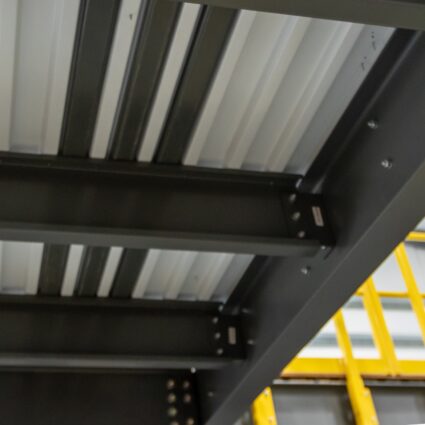Concrete Deck vs Steel Deck Platforms
Designing a warehouse or large facility requires robust and adaptable infrastructure with the right decking solution. As construction teams, architects, and business owners consider their decking options for elevated platforms, two primary contenders often emerge: concrete and steel deck platforms.
Each material offers unique benefits and challenges, influencing flexibility, cost, and sustainability. From the load-bearing capacities and installation timelines to cost-effectiveness and environmental impact, below, we provide you with the insights needed to make an informed decision.
Concrete Deck Platforms
A concrete deck platform is viewed by consumers as having the most flexibility to adjust equipment locations and is ideal for heavy-duty applications. Typically composed of reinforced concrete, these decks are designed to handle large point loads, and support heavy material handling equipment such as pallet jacks and light forklifts.
Additional attributes for concrete deck platforms include:
- Customized thickness to meet customer requirements.
- Various treatments or finishes can enhance functionality and aesthetic appeal.
- The ability to handle very high loads.
- Extremely durable and offers a long lifespan.
- Inherently fire-resistant, providing an added layer of safety in commercial and industrial buildings.
- Excellent sound-dampening properties, contributing to safer and quieter work environments.
Steel Deck Platforms
Steel deck platforms, like ResinDek®, are an increasingly popular choice in many construction projects due to its versatility and a range of beneficial attributes.
Some key characteristics include:
- Significantly lighter than concrete, reducing the load on underlying structures.
- Ease of installation and reduced material needs often translate to lower overall project costs
- Prefabricated steel decks allow for rapid assembly and installation, accelerating construction timelines.
- Steel decks can be engineered to meet specific dimensions and shapes, offering great flexibility.
- Reduced footing sizes.
- Individual panels can be removed and replaced without having to refinish the entire floor.
Which type of decking is right for you? We compare several key factors below.
Comparing Concrete Platforms Vs Steel Platforms
Platform Thickness
Dimensionally, a concrete deck is typically thicker with a minimum thickness of 3 1/2”, accounting for the roof deck and concrete thickness over the top.
Steel deck can be up to 2 1/4” thick for a roof deck/Resindek® system or as little as 1/4” thick with a floor plate system. This may not seem like much of a difference but an inch or two could mean the difference between providing a code-compliant walkway underneath or having enough package clearance for a conveyor.
In a facility where conveyors are a main attribute, allowing for maximum utilization of space is a top priority. Concrete does not always allow for this unless planned for when the building was constructed. In facilities for many industries, flexibility with space utilization is important, and steel is the best material for that.
Platform Weight
Concrete deck is exceptionally heavier than a steel deck system. In fact, ResinDek panels are often 85-90% lighter than concrete.
- The minimum concrete thickness of 3 1/2” deck imposes a dead load of about 27 psf with systems possibly going up to 97 psf for thicker slabs.
- A steel deck system imposes a dead load ranging from 5-10 psf.
With the added weight of a concrete deck comes the potential for larger framing members and higher seismic forces. This increases your overall steel cost and creates larger column point loads on the floor slab below.
Platform Levelness
A steel decking platform system delivers a more consistent finish than concrete when you compare floor flatness, levelness, and surface roughness.
How is this achieved?
- Steel decking panels are designed to ensure a level flooring surface with just the right amount of surface roughness to avoid the impairment of a robot navigation.
- Panels do not produce dust, require sealing, or crack like concrete.
- Concrete floors often require patching, creating problems for robot navigation.
- Steel deck options offer superior wear resistance when compared to concrete flooring.
Construction and Installation
There are several significant installation considerations when you compare concrete and steel deck options.
- A steel platform often comes with a factory finish, which means it can be installed and used immediately. Concrete on the other hand, requires 10 days of curing time, along with additional screeding and leveling work.
- Concrete platforms are heavier and require additional steel support during construction. With a lighter-weight design, steel platforms can be installed quickly because they use less structural steel and manual labor to erect.
- For installers who are not familiar with concrete construction, a subcontractor may need to be hired which adds to coordination time for additional parties. There is additional equipment that needs to be accounted for in the construction of a concrete platform, increasing production cost.
- Unlike concrete, a steel platform deck does not require large expansion joints, which creates more design flexibility.
Growth Opportunities
When looking at the life cycle of an equipment platform, there are always modifications and relocations to consider. Steel deck systems are easier and cheaper to modify when deciding to expand or alter an existing platform. Using steel means there is more flexibility and the structure can be designed for specific and future modifications. If modifications need to be made with a concrete structure, the concrete must be destroyed, meaning higher costs and a longer project timeline.
Platform Cost: A Case Study
A large sporting goods retailer needed two identical mezzanines at their distribution center. So the question became, what type of flooring would provide the best value? Two identically sized mezzanines were constructed at the same distribution center and a cost analysis was performed.
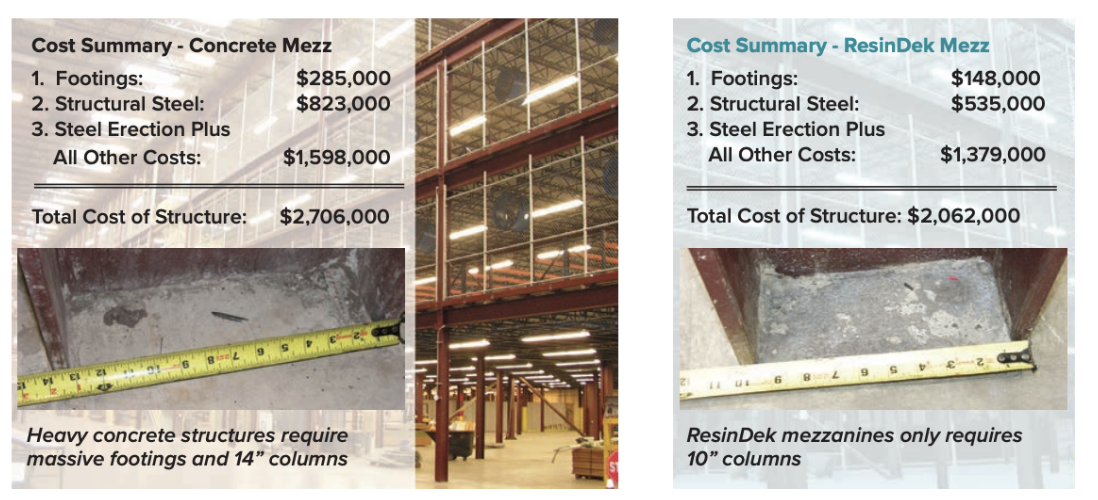 The results of the comparison demonstrate choosing a steel deck platform option, rather than concrete, resulted in significant savings.
The results of the comparison demonstrate choosing a steel deck platform option, rather than concrete, resulted in significant savings.Reduced Carbon Footprint with Steel Decking
An independent analysis confirms the ResinDek Hybrid Flooring System is dramatically greener than concrete.
- Concrete has a large carbon footprint to gather and transport raw materials, install the product, and to demolish the product at the end of life.
- ResinDek offers a smaller carbon footprint than concrete by utilizing less materials (resulting in fewer manufacturing emissions), requiring less labor to install, and by offering the ability to remove and replace individual panels as needed.
The decision of concrete or steel in any project is an important one for all end-users and integrators. Steele Solutions is here to help ensure you make the right decision for your requirements
At Steele Solutions, we work with you to design and manufacture structures that can handle the loads necessary for each unique project. Moreover, we work with each client to ensure that the final structure is what the end-user needs and fits into the approved budget.
Interested in learning more?
Reach out to our team for additional information on platform decking or review our additional resources on the topic:

